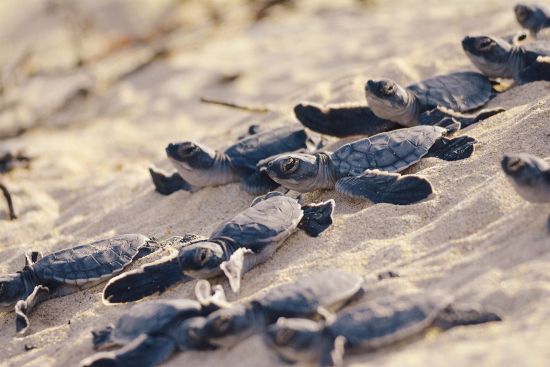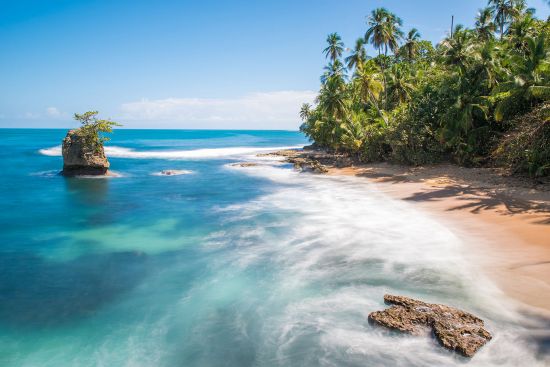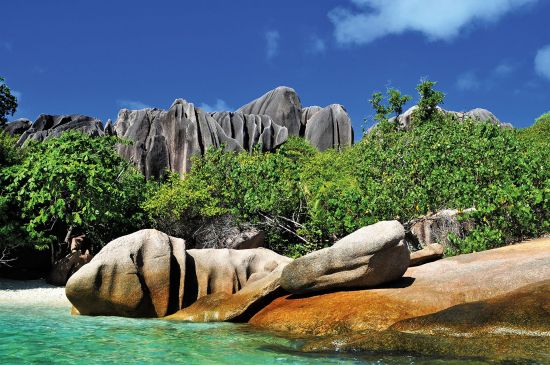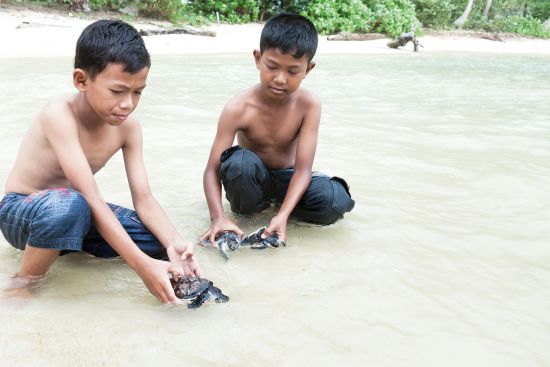
The Great Egg Race: Where to Watch Sea Turtles Hatch
Emerging from the nest and dashing for the sea, baby turtles are one of the most intriguing – and endearing – sights in nature
It was just another balmy September afternoon on the Platinum Coast of Barbados, with a few clouds dotting the sky and the sun’s intensity beginning to cool. Then, a little further down the beach, we spotted a group of people gathered round a spot on the sand.
Wandering over, we were just in time to witness something remarkable. Before our eyes, dozens of leatherback turtle hatchlings were emerging from their nest and being scooped up by local conservationists. Turtle hatchlings need nocturnal cues to find their way into the ocean, so the conservationists were moving them to a place of safety.
Sadly, only one in 1,000 baby sea turtles will make it to adulthood, so the prospects for this bunch weren’t good, even with human assistance. When looking for a good place to nest, sea turtles head for warm, wide, sandy beaches. Increasingly that means they must share their nesting spots with tourists, but many beach resorts are now helping to protect these endangered creatures.
The hatchlings break out of their eggs after 45 to 70 days’ incubation. Once hatched, they remain in the nest for a few days to absorb their yolk, which gives them the energy for their journey to the water. When it’s time for them to dig their way out, they usually remain near the surface until the sand temperature cools, which tells them that night has fallen. The hatchlings then use the slope of the beach, the waves and the natural light over the ocean horizon to help them find the sea.
Once they have run the gauntlet and reached the shore, they swim for their lives, paddling away from the shallows where the risk of being eaten by predators is highest. If they make it to deeper waters they will be on their own, living off molluscs, crustaceans, seaweed, jellyfish and fish eggs.
Hatchings take place at different times of year, depending on the location. The exact moment is hard to predict, and sightings can never be guaranteed, but the main sea-turtle populations are in tropical regions, many of which you can reach by cruise. (Also see our guide to the top 10 cruise destinations for wildlife.) So, if you want to see this amazing natural phenomenon, where should you head? Here are four of the world’s best places to watch sea turtles hatch.

Costa Rica
Home to many nesting beaches for four turtle species – leatherback, green, hawksbill and olive ridley – Costa Rica is something of a sea-turtle paradise. You should have a good chance of seeing them if you plan ahead; they lay their eggs on beaches on both the Pacific and Caribbean coasts all year round, meaning hatchlings are entering the world daily. On the Pacific shores, head to Ostional and Nancite beaches to see olive ridleys: the ideal time is a few days around the new moon, between August and November.
For your best chance to view a hatching, head along either coast to a turtle conservation project, where you’ll find nurseries. Conservationists watch for nesting turtles, dig up all or a proportion of the eggs after the mother returns to the sea, and re-bury them in an egg incubator. Gestation periods are well known, so hatching dates can be predicted several weeks in advance – although there’s no online schedule so you may have to do a little asking around.
Atlantic green sea turtles nest in large numbers on the northern Caribbean beaches from mid-June to early November. In season, a sighting is almost a dead cert. Beaches are closed to the public from sunset to sunrise and patrolled by rangers, but you can see turtles by joining an officially guided tour at night, or by staying at a beach-side lodge. Early morning is a good time to see hatchlings, and the best months are from July to October.

Seychelles
The islands in the Seychelles have one of the five largest populations of hawksbill turtle left in the world. Nesting season is from September to March, while hatchling season is from January to March. The turtles lay their eggs in daylight (according to experts, the Seychelles is one of only two places where they feel safe enough to do this) and the best spots to see nesting hawksbills are on Bird, Denis, Cousin, Cousine, North, Alphonse and Frégate islands.
From January to September, you can also see nesting populations of the larger green turtle; head to Aldabra, Cosmoledo, Astove and Farquhar atolls (though unlike hawksbills, green turtles tend to nest at night). The south of Mahé has some of the richest nesting grounds, with Anse Intendance and Anse Forbans listed as nesting zones.
Wildlife preservation is taken seriously in this part of the world, and sea turtles are protected by law. One of the most important sites for conservation is Curieuse island, while at Coco and Félicité islands you can spot green turtles from June to September, and hawksbill hatchlings between December and March.
A number of hotels have their own nesting beaches and are heavily involved in conservation programmes. North Island is home to both green and hawksbill turtle nests, and guests can help to tag adult turtles for research purposes.

Malaysia
Malaysia is home to leatherback, green, hawksbill and olive ridley turtles, although there has been a huge decline in the population of leatherbacks and their survival is in doubt. The largest population of hawksbills – also critically endangered – can be found in the ‘Turtle Islands’ of Sabah. Visit between July and October and you stand a good chance of seeing them arrive on the shores of Turtle Island Park in Sandakan, especially if you’re there after nightfall.
Known as penyu agar to the locals, green turtles are plentiful, nesting on the sandy beaches and islands of Sabah, Sarawak, Terengganu, Johor and Perak. On the east coast of Tioman Island in Pahang, you can watch turtles hatch on the desolate Juara Beach. A conservation project is in operation here, and you can sponsor a nest and release the hatchlings back into the ocean. Also in Pahang is Cherating Turtle Sanctuary, a small conservation hatchery: visit between July and October and you can see the hatchlings make their first foray into the world.

Mexico
Since its government banned turtle hunting in 1990, Mexico has developed one of the most comprehensive sea turtle protection programmes in the world. Six of the world’s seven species arrive in Mexico to lay their eggs each year, and the population of olive ridley turtles is on the rise, thanks to conservation efforts. Two key areas are the Baja California Peninsula on the Pacific coast and the Yucatan Peninsula on the Caribbean/Gulf of Mexico. The egg-laying season runs from June to November.
Not only a popular beach resort, Puerto Vallarta is also home to nesting olive ridley, leatherback, green and hawksbill turtles. The resort has been supporting local sea turtle protection programmes for 30 years, and there is controlled release of hatchlings most nights during the peak season of July to September.
You can also visit La Escobilla beach or the turtle sanctuary in Oaxaca – hatchlings enter the world between August and October – while other Pacific coast locations include Mazatlan, Costalegre and Manzanillo. On the Yucatan Peninsula, head for Akumal Bay, Xcacel Beach and Rio Lagartos.
